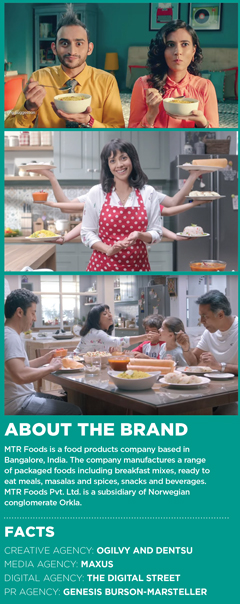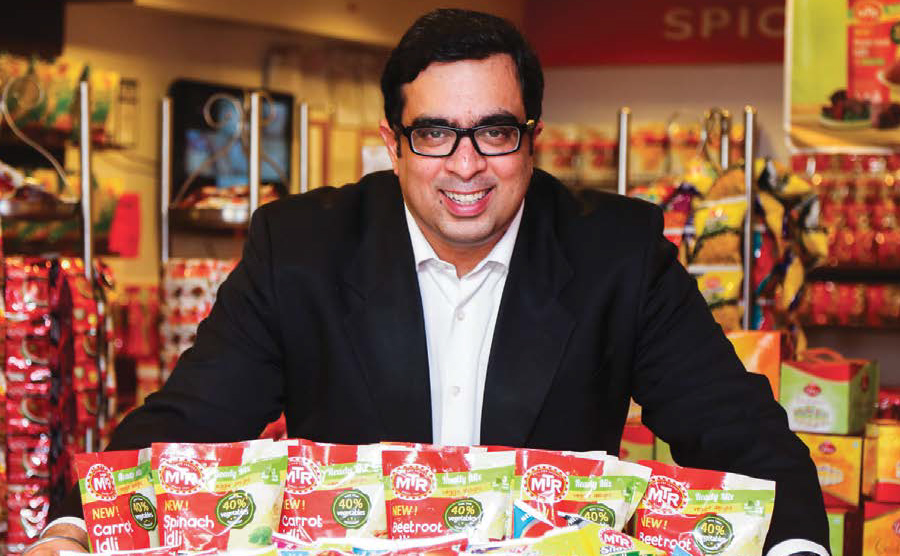We started off in 1924, and our initial roots were of course the restaurant. The packaged food business started somewhere in the mid-70’s. From there on, we expanded from Bangalore to Karnataka to Southern India, and we are now building the brand across India.
Over the last two years, our journey has been about consolidating what we stand for, which is great taste and convenient Indian food for which we are talking to the homemakers and adding new avenues which traditionally we have not covered. We are talking to a new set of audiences, the millennials, for our 3 Minute Breakfasts. That was one specific shift we made last year, along with getting into the confectionery category through our parent company, Orkla. Our brand underwent a transformation both in logo and packaging and even the tonality in advertising changed.
Q] It is now been more than a year since the brand transformation and the addition of new target groups to your products. How has it worked out for you so far?
We had traditionally not spoken to the millennials at all and that was one gap in our portfolio. We dug deeper and realized that one of the things that Indian breakfast was not doing was making it more convenient for consumers, especially during rushed mornings on weekdays. We developed this whole concept of ‘3 Minute Breakfast’ where you just need to add hot water to the mix and it is ready in three minutes. In fact this launch has been the biggest New Product Development (NPD) launch for MTR so far.
From a business point of view, this segment is now contributing over 20% to our overall breakfast sale on a regular basis and has helped us gain 5% share in the breakfast market. Our aspirations are much bigger and we are continuing to sharpen our play by building on it.
 Q] What has been your key challenge in this entire process? What have been your learnings through this and how do you plan to sharpen it further?
Q] What has been your key challenge in this entire process? What have been your learnings through this and how do you plan to sharpen it further?When you get into a new space, learnings come from multiple fronts. We had a great consumer understanding that obviously gave us a good head start. The challenges that have come were more internal. We were talking to a new set of customers who demand you to be present on a certain channel and certain place that you may not have been present in earlier. So we had to learn, unlearn and relearn very quickly. Similarly, we have had to obviously look at all our product and packaging plays, and then quickly assess what is working well, where the gaps are and what we can leverage better.
Fox example, we were doing pouches, boxes cups, but there was a consumer need that really came through where people wanted a big size pack between a box and a pouch, which did not exist. In the last quarter, we actually launched our Poha in that pack size. We have also significantly increased the use of Digital in our overall marketing play.
Q] Being a brand from South India, have you been able to garner the kind of national presence that other brands in the category enjoy?
In the breakfast space, actually North is our biggest market. That gives you an indication that it’s not just about South. Overall also as a business, we have more than 20-22% of our overall domestic sales coming from outside of South India.
Q] Is it more difficult to sell Indian breakfast items to Indians, in comparison to Western breakfast options like cornflakes and oats?
When it comes to your own food, I think your process of evaluation is far more stringent. So, if you are a Gujarati and I was to sell you a khaman dhokla, you would be far more critical in your evaluation because you have grown up eating it. Now, if I were to sell the same product in the South, where consumers possibly don’t have a comparative degree of evaluation in their minds, it might actually be much easier. So, I think that’s the challenge in Indian breakfast options vis-a-vis western breakfast options such as cornflakes, muesli, oats, etc. People tend to be a lot more accepting even if your product doesn’t fully deliver, because they don’t know what to really expect. When it comes to Indian food, or your own food, the evaluation criteria is a lot more stringent and far more discerning, and that’s a tough battle to win. So each time we launch a product, it needs to be absolutely impeccable, both in terms of quality and taste.
Q] With more brands coming up with similar products, what is your strategy to slide through competition?
We view competition as a great thing because essentially when you have more and more competitors coming in, it is an indication that your strategy is somewhere going right. Secondly, competition helps the category grow faster, because everybody makes an effort to grow the category together. Given where we are today, there is enough room for everybody to come in and really grow well. So, yes, a lot of them are actually coming in and trying different things. We have a road map and a well defined play within our own system, which we are building up on.
Q] In your confectionery category, Laban’s first campaign has been received well among kids. How do you plan to take it forward?
It is not even a year that we have entered this category. And we have a 6% share in the category now, which is a fairly good start. This category thrives on continuous excitement, so that’s one thing that we are obviously striving to deliver all the time and you will see more and more exciting things come from Laban’s stable and from MTR in this category in the days and months to come.
Q] Recently MTR made an investment in Timios. Can you share more details on that?
Last year, we had kept aside Rs 50 crore as MTR seed fund. Timios, a local entrepreneur brand which is into the nutrition space, is our first investment into that category and it continues to operate as a separate entity.























